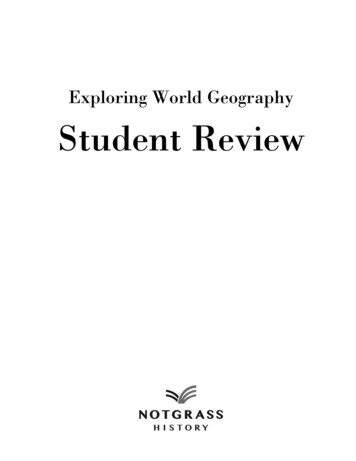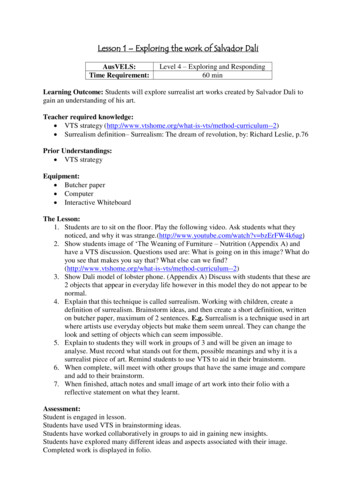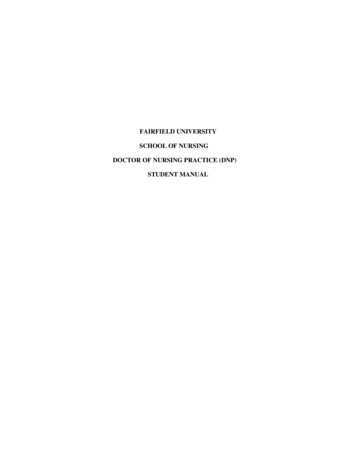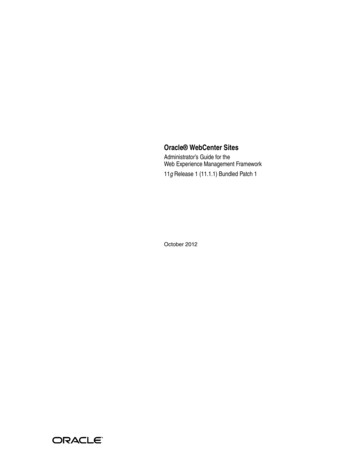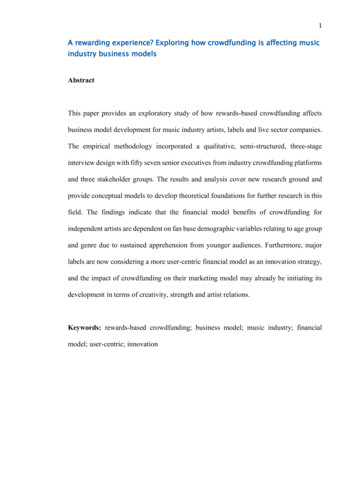
Transcription
1A rewarding experience? Exploring how crowdfunding is affecting musicindustry business modelsAbstractThis paper provides an exploratory study of how rewards-based crowdfunding affectsbusiness model development for music industry artists, labels and live sector companies.The empirical methodology incorporated a qualitative, semi-structured, three-stageinterview design with fifty seven senior executives from industry crowdfunding platformsand three stakeholder groups. The results and analysis cover new research ground andprovide conceptual models to develop theoretical foundations for further research in thisfield. The findings indicate that the financial model benefits of crowdfunding forindependent artists are dependent on fan base demographic variables relating to age groupand genre due to sustained apprehension from younger audiences. Furthermore, majorlabels are now considering a more user-centric financial model as an innovation strategy,and the impact of crowdfunding on their marketing model may already be initiating itsdevelopment in terms of creativity, strength and artist relations.Keywords: rewards-based crowdfunding; business model; music industry; financialmodel; user-centric; innovation
21. IntroductionThis paper will explore the nature of how rewards-based crowdfunding affects businessmodel (BM) development in the music industry (including both recorded and live musicsectors). In this industry over 90% of organisations are comprised of fewer than 250employees and changes in the innovation and BM landscape have been driven as muchby start-ups as by the global corporations (IFPI, 2013). With regard to BMs, Bourreau etal. (2012) have expressed that “[v]ery few papers have taken a broader view, to analysethe effects of digitization on [music industry] business models” (p. 416). Lysonski andDurvasula (2008) have also stressed the need for more research into the music industrythat would establish the practicability of different BMs. The recurring themes in theseacademic calls for research appear to be the need for a new industry-level BM or acombination of firm- or sector-level BMs for the music industry, with other scholarssupporting these ideas as a means of pursuing ideals such as sustainable revenue (Parryet al., 2014a; Sirkeci and Magnúsdóttir, 2011) or the provision of attractive alternativeoptions to illegal file-sharing (Papies et al., 2011).Dewenter et al. (2012) have demonstrated in their research findings that musicindustry BMs which are integrated with consumer involvement through file sharing canresult in both recorded and live sector benefits in terms of profitability and productvariety. Consequently, they call for future research to further explore what they describeas ‘richer models’ for the industry. The current paper will endeavour to contribute to thecontemporary academic research in this field by empirically exploring the developmentof new music industry BMs that are integrated with consumer involvement via rewardsbased crowdfunding.Crowdfunding is a type of crowdsourcing in which an individual or enterpriseseeks to accumulate the funds for a project or venture by reaching out to the general public
3and requesting individual donations that contribute towards a target financial goal. Unlikeequity-based crowdfunding in which contributors essentially become stakeholdersthrough angel investment and equity procurement, rewards-based crowdfunding is morecommonplace, simplistic and popular with consumers, at least partly on account of theexposure gained by celebrity ventures, in addition to the proliferation of prominentplatform websites. For instance, the Kickstarter platform (www.kickstarter.com)describes itself on its official website as a global community of over ten million peopleworldwide who have funded creative projects advertised through the website. Theplatform provides step-by-step guidance for building your project, getting feedback,launching the venture, tracking the funding progress and then facilitating the allocationof ‘rewards’ once the financial target has been accomplished. With the nature of rewardsbased crowdfunding, these ‘rewards’ to investors may take the form of discountedproducts/services relating to the crowdfunded venture or entry into a draw to win avaluable item (such as limited edition merchandise or signed memorabilia) or experiencerelated to the venture.Rewards-based crowdfunding is growing in the variety of sectors to which it isapplied (e.g., music, sports, video games, education, retail) (Agrawal et al., 2011). In fact,statistics on the Kickstarter website illustrate that the sector reach of crowdfunding nowextends to more obscure industries such as crafts, fashion, food and publishing. As eachindustry exhibits a potentially new range of available rewards for willing consumers, thepossibilities of the platform are only limited by the imagination and the attention spansof the contributors. However, as the rewards-based system has been in existence sinceMarillion’s 1997 album and crowdfunding revenue figures are still continuing to rise, theindications are that this will remain a high growth sector for the foreseeable future. Likemost technologically-driven industry sectors, the crowdfunding domain is an oligopolisticmarket that is dominated by a few key players. Aside from the aforementioned
4Kickstarter, the platforms GoFundMe and Indiegogo are also ranked in the top 3 ofrewards-based crowdfunding platforms according to the www.crowdfunding.comwebsite (based on independent traffic data from digital analytics companies Alexa andCompete).Zheng et al. (2014) recently advised that crowdfunding has developed into aprevalent practice within the music industry on account of fan involvement in the creativeside of music production. This statement is compounded with official statistics on theKickstarter website that indicate that 46,251 music crowdfunding projects have beenlaunched through their platform since 2009. In spite of this, few studies have specificallyfocused on how this growing phenomenon is shaping the business modelling of keystakeholders within the industry. As a direct result of this, there have been recentsuggestions that there exists a lack of clarity of how exactly crowdfunding might ‘changethe game’ for new ventures that seek financing. The current study will address this gap inresearch and knowledge by investigating how rewards-based crowdfunding is affectingboth new and established industry players in order to determine the practical implicationsof these new BM developments across different industry sectors.The paper will be structured as follows. Section 2 will provide a brief overviewof how a BM is conceptualised and constructed. It will then review the academic literaturein relation to the contemporary challenges associated with music industry BMs and theemergence of new models within the industry. The literature on music crowdfunding willthen be reviewed from the context of BM implications. The theoretical development ofthe paper will then be stated in which research questions will be proposed. Section 3 willpresent the research methodology in which the methodological position and design arestated and the data analysis approach is justified and detailed. Section 4 will present theresults and analysis of the three interview stages in terms of how they correlate to theresearch questions and the existing literature. Section 5 will then draw logical conclusions
5from the findings and demonstrate the contribution of the current study to theory, practiceand future research.2. Literature review2.1Defining a business modelZott and Amit (2010) define a BM from an entrepreneurial management perspective as“a template of how a firm conducts business, how it delivers value to stakeholders [ ]and how it links factor and product markets” (p. 222). This definition perceives the BMboth in terms of its organisational application as well as its functions; Demil and Lecocq(2010) conceptualise it instead from a more philosophical perspective by suggesting thatit constitutes the way in which an organisation operates with sustainability in mind. Theylater elaborate on this statement by claiming that it is also a snapshot of a given momentin time for the organisation. However, Cavalcante et al. (2011) advise against thesnapshot approach as a static representation of the BM and argue for the importance ofBM change through the identification of its boundaries and mechanisms. Al-Debei andAvison (2010) also define the BM with time-frame considerations by suggesting that itcan be conceived as an abstract representation of organisational arrangements – designedand developed both presently and in the future. Doz and Kosonen (2010) provide a wayof observing the dichotomous dimensions of the BM concept by acknowledging theprospect of defining it in terms of either an objective or subjective approach. From theobjective perspective they define it as a set of structured and interdependent operationalrelationships with both internal organisational units and external stakeholders. From asubjective point of view they define it as the representation of the mechanisms throughwhich these relationships are implemented in the external environment.
6It is perhaps the objective perspective of the BM concept that is most readilyaccepted throughout the extant literature, with Mason and Spring (2011) proposing thatthis conceptualisation of the BM represents a ‘truth’ by describing how the businessworks. However, if the subjective perception of the BM relates to its actuality inimplementing this business know-how in practice then would it not be logically acceptedin the literature as the most influential approach for business practitioners? George andBock (2011) have demonstrated opposition to this standpoint by arguing that“[u]nderstanding BMs as a form of subjective and often retroactively adjudicatednarration does not match practitioner language” (p. 98). However, their arguments mayperhaps be influenced by their academic backgrounds and do not necessarily representthe true practitioner viewpoint on this issue.With the above discussion in mind, below is a summary of some potential definingcharacteristics that may be inclusive of a generic BM: It is a visual means consisting of a template, description or representation (Al-Debeiand Avison, 2010; Doz and Kosonen, 2010; Sandberg et al., 2011; Shafer et al., 2005;Zott and Amit, 2010); Its firm-related objectives include conceptualisation, summarising and understanding(Al-Debei and Avison, 2010; McGrath, 2010); It incorporates the complex network of internal and external component relationships(Chesbrough, 2006; Demil and Lecocq, 2010; Doz and Kosonen, 2010); It considers the firm from the context of both the present and future tense (Al-Debeiand Avison, 2010; Doganova and Eyquem-Renault, 2009); and It ascertains the firm’s potential in relation to value goal opportunities throughstrategic implementation (George and Bock, 2011; Kallio et al., 2006; Shafer et al.,2005; Zott and Amit, 2010).
7The next sub-section will take this working definition of a generic BM and apply it tothe chosen industry context in order to review the current BM landscape of the musicindustry, what are the current associated challenges and which types of BMs are the mostappropriate to the current study.2.2Current business models in the music industryThe majority of the management literature that discusses redistribution of music industryBMs has concentrated on revenue models, with suggestions that this aspect depends on anumber of variables including network support approaches (Generator, 2011) or thequality of copyright protection (Teece, 2010). However, it is advisable that it is dependenton the preferences of the consumer, as it has been noted in the literature that consumerpayment inclinations over time are leaning more towards tiered imbursement plans (fromfreemium to premium) for streaming and subscription models and less towards the a-lacarte download to own revenue model. Hence, revenue streams are diversifying toincorporate other sectors of the industry such as live events, as Arewa (2010)acknowledges that “[u]nder existing music industry business models, top popularmusicians actually earn far more from concert ticket sales than from record salesroyalties” (p. 459). With this insight into how revenue streams in general are diffusinginto the live sector of the music industry, the companies which operate within this areamay therefore represent an appropriate stakeholder group from which to specifically andempirically explore one particular revenue model innovation such as crowdfunding.The next sub-sections will review the literature on the challenges associated withcontemporary music industry BMs and how some revenue model innovations such ascrowdfunding may be influencing BMs within the industry.
82.3Contemporary challenges for music industry business modelsThe a-la-carte legal download revenue model pioneered by Apple at the start of the digitalrevolution arguably drove consumers to devalue the legal music content. At the same timeit arguably incited the industry to constantly re-adapt its BM to create value for theconsumer through alternative distribution channels (Parry et al., 2014b). These disruptiveinnovations to existing distribution channels have undoubtedly brought uncertaintyregarding the sustainability of newly formulated industry BMs after any initial upwellingof interest in their originality (CCS, 2011). However, Lincoff (2008) also advises thatthis re-adaption of industry-sanctioned BMs may in itself prove problematic as hedescribes the associated license fees to the rights holders for these BMs as “so high as tolimit the number of services that can possibly participate in the lawful marketplace” (p.22).Another current challenge facing the industry is the attempt to regain control andauthority by way of the constant litigation and legal disputes that the industry haslaunched against not only some of the unlicensed digital music services but also the musicusers. Specifically, some of the major record labels have opted for legal action againstuser-driven innovations in music access and pricing models (Casadesus-Masanell andHervas-Drane, 2010; Kunze and Mai, 2007; Oestreicher and Kuzma, 2009). Essentially,these user innovations may prove problematic as once consumer creativity profoundlyaffects the original innovation the IP rights of the firm may become unclear with regardto technology licensing and patent approval (Harhoff et al., 2003; Herstatt andSchweisfurth, 2014; Lüthje et al., 2005; von Hippel, 2007). Due to the shifting dynamicsof the music industry and the arguable re-positioning of the role of the major record labelswithin the market, they may represent a stakeholder group from which to explore theextent to which they are approaching changes to their own financial model and becomingmore accepting towards consumer involvement in the process.
9In competitive markets such as the digital music market, failures to innovate BMswill not only lead to the demise of certain key industry players on account of some of thecurrent BM issues, but will also lead to the emergence of new and innovative BMs forothers. This viewpoint is supported by scholars who suggest that some music artists haveresponded to industry failures to adopt new models by experimenting with new modelsthemselves (Arewa, 2010; Ericsson, 2010). With this alleged innovativeness on the partof independent artists in terms of willingness to experiment with new BMs, combinedwith the earlier literary suggestion that they are now beginning to integrate newtechnologically-focused elements into the core structure of their own BM, they mayrepresent a suitable stakeholder group for which the empirical data collection of thepresent study could be aimed.2.4Developing new business models for the music industryThe literature provides suggestions and advice as to which elements or features should bemost prominent in new music industry BMs. These suggestions include lower pricemargins on digital music downloads (Lysonski and Durvasula, 2008), a re-engineeredvalue chain (Oestreicher and Kuzma, 2009), co-operative arrangements for the youthdemographic (Lysonski and Durvasula, 2008) and a sustainable revenue stream (Parry etal., 2014a; Sirkeci and Magnúsdóttir, 2011; Styvén, 2010). Kappel (2009) suggests that“[t]he new model for the recording industry may be ‘no one model’ at all. Artists willclaw, scratch, bite, and kick their way into the industry” (p. 385). One means he mentionsis the aspect of incorporating crowdfunding into their BM as a method of co-creation ofvalue (and revenue) with the music users. The concept of rewards-based crowdfunding,whereby incentives are offered in exchange for financial contributions towards thedevelopment and production of an idea, product or service, is a relatively contemporaryphenomenon in business and management fields. Despite its origins lying with the
10precursor of ‘collective fundraising' in the 17th century, the modern concept ofcrowdfunding only emerged in 1997 with the campaigns of the British music bandMarillion; Figure 1 below illustrates the short, yet influential, evolution of the rise ofcrowdfunding and how it transcends various industries and countries. The next sectionwill now consider its application to – and impact on – BMs specifically within the musicindustry.[Figure 1 here]2.5How crowdfunding is affecting the music industryThere is very limited but interesting discussion of music industry crowdfunding in thepeer-reviewed academic literature. For example, some authors have alluded to theprospect that crowdfunding can help artists overcome financial limitations (Agrawal etal., 2011). According to Kappel (2009), crowdfunding models are more sustainable thanother conventional revenue streams. This is allegedly on account of a more balancedengagement level from consumers and the artist because “fans become literally investedin the success of their artists” (p. 376). The Kickerstarter statistics would certainly appearto reflect this as music crowdfunding projects through that platform have generated a totalof 155.76 million (from a target of 171.62 million) since it was launched in 2009.Kappel (2009) also suggests that crowdfunding models, if successful, could potentiallycounteract the devaluing of all recorded music - arguably one of the most prominentissues currently facing the music industry today. In terms of how specifically thisperception shift will occur, he expressed that it may be realised through exposing theconsumers to marketplace realities and debunking the hostile mentality betweenconsumers and the industry. It may also be perceived as a way for the industry to (attemptto) regain control of revenue streams as, although the amount raised is unpredictable and
11subject to circumstantial risks, the consumers’ involvement and control is limited tofinancial contributions and the loyalty rewards may be sufficient to satisfy the moreaffluent music fans. However, Ordanini et al. (2011) maintain that crowdfunding modelsdo empower the fans as well as the artists in a global community, and suggest that loyaltyrewards may extend beyond mere music content or merchandise to a share of the revenuegenerated by the artist. This approach could potentially offset the social preferencesrelating to apprehensions for reciprocity that may constitute a driver for consumers whoengage in crowdfunding activities (Regner and Barria, 2009). In addition to consumermotivations, other authors have raised concerns over the negative, de-motivationalconnotations associated with failed or sub-standard crowdfunding projects (Buff andAlhadeff, 2013).The limited literature discussion on crowdfunding within the music industry hasexhibited much ambiguity about which specific sectors, areas of players within theindustry are being affected by crowdfunding in terms of BM development. Through thepreceding sub-sections, it has emerged through the broader review of music industry BMsthat the independent artists, major record labels and live sector firms may represent keystakeholders from which to focus the empirical exploration of this research topic. Thenext sub-section will consider the state of theoretical development in the field of musicindustry crowdfunding and propose specific research questions to guide the datacollection stage.2.6Theoretical developmentThe initial literature reviews above have revealed a lack of theoretical development inrelation to how crowdfunding is effectively re-shaping the music industry in terms ofindustry stakeholders, BMs and sector landscapes. Any relevant discussion appears to bebased on speculation as opposed to qualitative, empirical investigation and analysis.
12There is somewhat ambiguous and descriptive discussion of how crowdfundingapplications may be influencing the practices of distinct yet correlational stakeholders ofartists, firms and end consumers. This accentuates how any initial implications of theseaspects that were suggested in the current literature are substantially lacking in terms ofempirical evidence and how they are directly and specifically affected in terms of BMdevelopment. The discussion does provide some tentative suggestions of associated BMimpacts relating to finance (in terms of sustainability, re-valuation, control strategies andgenerated shared revenue). However, the lack of in-depth analytical discussion, empiricalexploration or clarification of operation model crossover implications necessitatessignificantly more theoretical development of these concepts.An initial review of crowdfunding literature from a non-music industry contextprovides substantially more theoretical development in terms of the influence ofcrowdfunding on the current business landscape. For instance, Belleflamme et al. (2013)suggest that crowdfunding involving pre-order elements has associated advantages interms of how advanced sales help to identify and reward the most proactive consumersand thus to practise price discrimination. However, they also suggest that a keydisadvantage lies in how these pre-sales must be of an amount that covers the start-upcapital requirement, thus potentially restricting lucrative price discrimination. They thendevelop a theoretical framework for crowdfunding in which they hypothesise that,although it has the potential to enhance profits by attaining a larger portion of theconsumer surplus, the price discrimination strategy may become distorted due to theconstraints associated with the initial capital to be raised. Lehner (2013) also suggests thatthe success of crowdfunding is dependent on the strategic adaptation of industry modelsto facilitate communication means as an alternative to the inclusion of end-consumers inthe decision-making process. He also alluded to the possibility that the impact of largescale crowdfunding can have non-financial BM implications such as elevated levels of
13attractiveness of the company in terms of future investment and employment, in additionto what he describes as “a refined outlook of what is really needed through the feedbackof the many” (p. 300).Although the conceptual models of crowdfunding as proposed by the aboveauthors are not fundamentally applicable to the unique and interconnected businesslandscape of the music industry and the relationships that exist between its stakeholdergroups, nevertheless the theoretical underpinnings of the above discussion may haveinvaluable implications if used as the foundation from which to empirically explore thechosen industry context of the current study. For example, the work by Belleflamme etal. (2013) as well as Griffin (2012) highlights the significance of ascertaining the impacts– both positive and negative – that crowdfunding is having on the financial model ofspecific industry stakeholders and what are their related approaches to this kind of BMdevelopment. One isolated statement in the literature by Kappel (2009) has suggested thatcrowdfunding may prove to be more sustainable than alternative revenue models forartists. In order to contribute towards the theoretical development of this topic, the currentstudy will explore not only the validity of this statement but also the holistic implicationsfor this and the other identified stakeholder groups within the music industry.Consequently, the first research question to be empirically investigated will be:Research Question 1: How is crowdfunding in the music industry affecting the waysin which key stakeholder groups approach and develop their financial models?The theoretical contribution by Lehner (2013) addressed the concept of how the impactof crowdfunding may actually have non-financial BM implications that can provebeneficial to the industry company in terms of its attractiveness and employee quality. Inthe music industry literature, Zheng et al. (2014) raised the possibility that crowdfunding
14has become prevalent throughout the industry at least partly due to fan involvement in thecreative side of music production. This viewpoint echoes a statement by DubossonTorbay et al. (2002) that cost/revenue models can influence other BMs related tocustomer relationships or product/service production. Therefore, in order to make atheoretical contribution to this topic, the current study could also explore howcrowdfunding is affecting the identified stakeholder groups in terms of other BMs suchas marketing and production models. Consequently, the second research question to beempirically investigated will be:Research question 2: What are the crossover implications of these consumer-drivenfinancial model developments on other associated business models of thestakeholders?Lehner (2013) also proposed in his theoretical discussion that the success ofcrowdfunding may be reliant on the strategic adaptation of industry models to facilitatecertain key attributes such as communication means. Incidentally, Kappel (2009) advisedthat the reconfiguration of the balance of engagement levels between artists and fanscould ensure the sustainability of crowdfunding. Therefore, the current study couldaddress the question of what other BM adaptations may facilitate crowdfunding successwithin the music industry in the medium to long term – this may be especially pertinentwhen one considers both the constantly shifting business landscape of the industry andthe number of stakeholders who have yet to strategically align their BM operations tointegrate crowdfunding elements. Consequently, the third research questions to beempirically investigated will be:
15Research question 3: What future adaptation strategies should these industrystakeholders, organisations or sectors take in order to maximise the efficiency oftheir user-centric business model innovations?By conducting an exploratory study which addresses this emerging field ofcrowdfunding within the music industry, this paper will aim to make a valuablecontribution to theoretical development in this field by covering new research ground andfacilitating a superior clarity and configuration of theory, knowledge and understanding.This approach could potentially initiate more focussed and germane additional empiricalresearch to concentrate on the critical issues and challenges that have been overlooked inthe research so far. It could also result in an improved perception of crowdfunding as ajustifiable and essential business strategy for companies – both internal and external tothe creative industries - and not exclusively an academic exercise. It may consequentlyhave repercussions at the industry and policy level.3. Research Methodology3.1Methodological position and designIt was decided to adopt an interpretive epistemological approach to the researchmethodology of this study due to the exploratory and emergent nature of the phenomenaunder consideration, as consistent with the philosophical positions of other scholars(Grant et al., 2012; Qu and Dumay, 2011). For instance, Allard-Poesi (2005) providedclarity on the ontological position of an interpretive epistemology by stating that it seeks
16to develop and objective social science of subjectivity. Other key academics haveemphasised that, on account of how interpretivism epitomises an ontological realitywhere knowledge is derived from socially constructed meanings or consciousness(Cardoso and Ramos, 2012; Rowlands, 2005). Harris (2000) crystallises theseparadigmatic anomalies by stating that “[t]he interpretative requirement is to capture thecomplexity and subjectivity inherent within user-centric innovation in order to help buildand refine theoretical propositions and to enrich findings” (p. 756). Based on the abovediscussion points, it was therefore concluded that, due to the exploratory and opinionbased nature of the research aim of the current study, an interpretive epistemology wouldbe adopted.Based on the interpretive and exploratory nature of the research area, (Grant etal., 2012; Qu and Dumay, 2011), it was decided to adopt a multi-stage interview-basedresearch method. In terms of the nature of the population of interviewee candidates, thisstudy – like most music industry studies – was not geographically limited due to the socialand online reach of the global music industry (Chaney, 2012; Choi and Burnes, 2013;Gamble and Gilmore, 2013; Izvercian and Alina Seran, 2013; Power and Hallencreutz,2007; Soriano et al., 2008; Warr and Goode, 2011). Therefore, candidates from aroundthe world were considered suitable representatives for the study if they either held a seniormanagement position in their organisation (the vast majority were either the companyCEO or Director) or substantial relevant experience/knowledge in the field of theinterview stage.Stage One of the interview design consisted of thirty four interviews with musicindustry profes
through angel investment and equity procurement, rewards-based crowdfunding is more commonplace, simplistic and popular with consumers, at least partly on account of the . 2010; Doganova and Eyquem-Renault, 2009); and . The majority of the management literature that discusses redistribution of music industry



